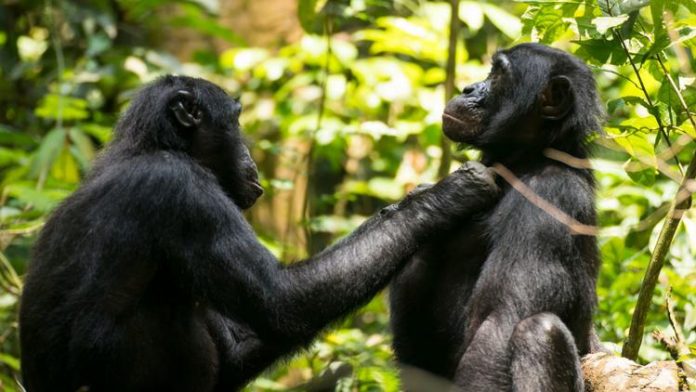Aging bonobos get farsighted, and their social lives suffer for it.
Scientists figured this out by spying on a colony of 14 wild bonobos living in a reserve in the Democratic Republic of Congo. When the primates groomed their companions, the younger members of the group sat close to their partners while the older members sat farther away, according to a report published Monday in the journal Current Biology.
The researchers’ interpretation: Older bonobos couldn’t see the dirt and lice in their companions’ fur if they were too close, just like older people have trouble reading words that are too close to their eyes.
Considering that bonobos (along with chimpanzees) are our closest living relatives, perhaps this shouldn’t come as a huge surprise. Still, the scientists who made this discovery say it may help them understand why humans live so long after our reproductive years end.
Presbyopia, the name for this vision condition, is a common consequence of aging. The lens of the young eye is flexible enough to change its shape so it can focus on close-up objects. But around the age of 35, the lens starts to become more stiff and the muscles that control it start to weaken. These changes rob the eye of its ability to focus on things that are very close, according to the National Eye Institute.
(This is not the same as farsightedness, which occurs when the shape of the eye prevents a person from seeing nearby objects clearly.)
The study authors, from Kyoto University in Japan and the University of St. Andrew in Scotland, watched the wild bonobos over four months in 2015. Four of the 14 animals were definitely in their 40s, based on observations going back to the 1970s. A fifth bonobo was estimated to be 40 at the time of the study, though he might have been a couple of years older or younger.
The researchers monitored the animals from a distance and took pictures when they had an unobstructed view of them grooming. They used the photos calculate the precise distance between the groomer’s eye and his or her fingertips.
The pattern was clear, they wrote: “Grooming distance exponentially increased with age.”
But how could they be sure the five older animals hadn’t always groomed from a greater distance than the nine younger ones?
As it happened, the researchers had video footage of one of the older bonobos, 41-year-old Ki, from 2009. They took four snapshots from that video and found that Ki’s average grooming distance back then was 11.91 centimeters. Six years later, when the new pictures were taken, her average grooming distance had increased to 16.95 centimeters.
“This is compelling evidence that Ki’s grooming distance had indeed increased with age,” the researchers wrote, and the same was probably true for the other animals.
No differences were found between males and females.
The results suggest that “presbyopia is not a by-product of the modern human lifestyle, which demands near visual tasks,” the study authors wrote.
In other words, you can stop blaming your computer and your iPhone for ruining your eyes.
But the significance of this discovery goes well beyond that.
In the wild, male chimpanzees rarely live to the age of 40, but male bonobos often do. This may be due to the fact that bonobos live in more peaceful societies, making life easier for the elderly, the study authors wrote.
Further field studies would be needed to confirm this, but if the theory holds up, it would suggest that humans, too, owe our longevity in part to our “cohesive and mild social environments,” the study authors wrote.















